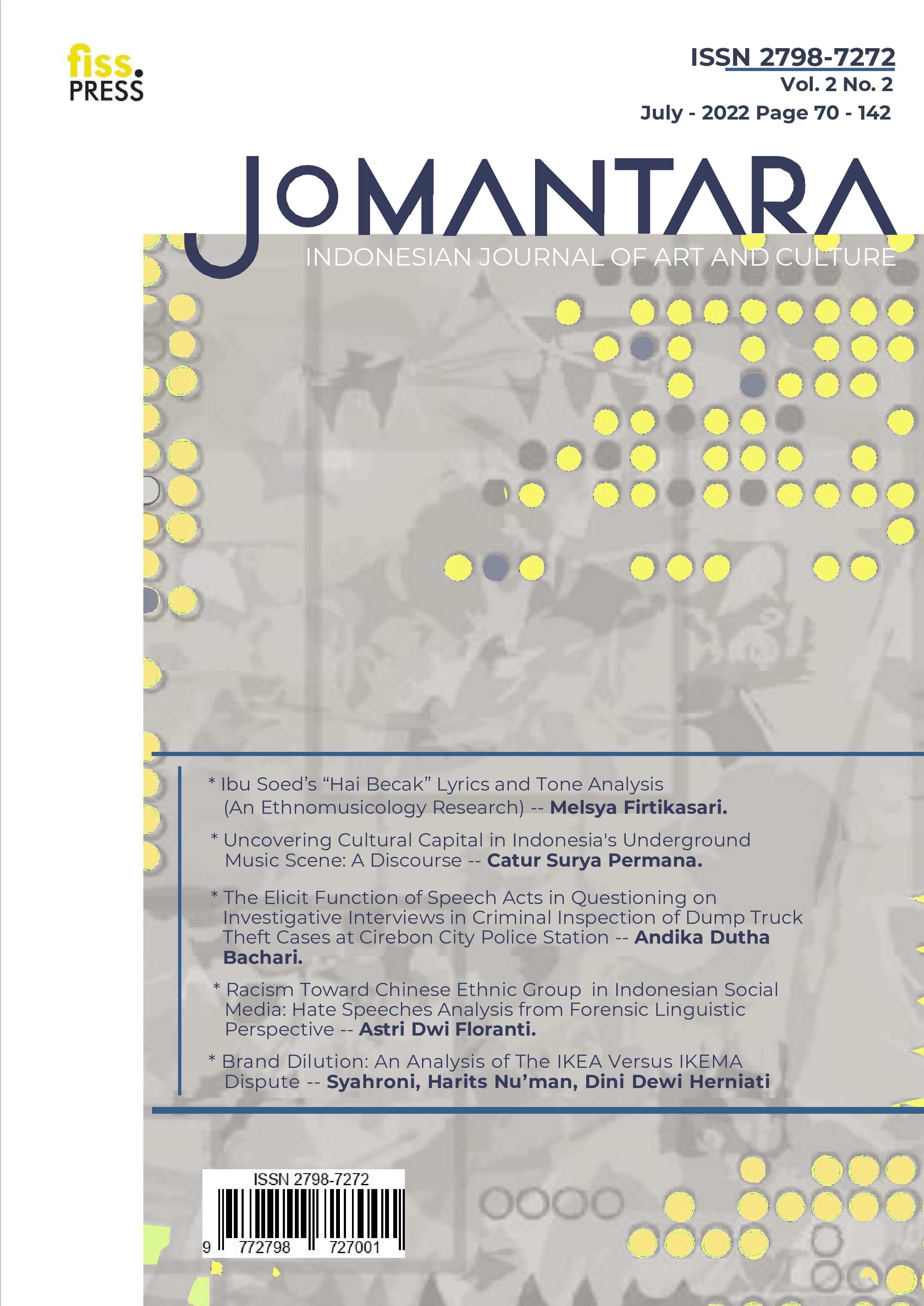Racism Toward Chinese Ethnic Group in Indonesian Social Media: Hate Speeches Analysis from Forensic Linguistic Perspective
DOI:
https://doi.org/10.23969/jijac.v2i2.5753Keywords:
hate speech, racism, Tionghoa ethnic, anti-Chinese, forensic linguisticsAbstract
Anti-Chinese sentiments are still deeply ingrained in the Indonesian public discourse. The issue of their identity and position is debatable that triggers to many discriminatory actions toward them. The purpose of this study is to analyze hate speech against Tionghoa ethnic expressed in Indonesian social media which has officially evaluated as a legal offense by the authorities. The theory of speech acts from Austin (1962) and Searle (1969) within forensic linguistic study are employed to examine the utterances and evaluate them in the context of Indonesian legal regulations. The data was obtained from Direktori Putusan Mahkamah Agungfrom 2019 - 2021. The results of the analysis reveal that hate speech portrays hurtful feelings and harmful attitudes. It is reflected by malice (expressive speech act), insulting or accusing (assertive speech act), persuading the others to commit crimes (directive speech act), planning crimes in the future time (commissive speech act). Then, there are 10 forms of pejorative labels toward Tionghoa ethnic. Race-based hate speeches expressed in the online media are prohibited in Article 28 paragraph (2) of The ITE Law Article Number 19 of 2016. They are prejudiced action, violate human rights and cannot be considered as freedom of opinion and democracy because of their dangerous perlocutionary effects. The effects can provoke discriminatory action and even crime.
Downloads
References
Austin, J. . (1962). Austin J. L. -How to Do Things With Words. In Oxford applied linguistics. Harvard University Press.
Bilewicz, M., & Soral, W. (2020). Hate Speech Epidemic. The Dynamic Effects of Derogatory Language on Intergroup Relations and Political Radicalization. Political Psychology, 41(S1), 3–33. https://doi.org/10.1111/pops.12670
Carney, T. (2014). Being (im)polite: A forensic linguistic approach to interpreting a hate speech case. Language Matters, 45(3), 325–341. https://doi.org/10.1080/10228195.2014.959545
Castaño-Pulgarín, S. A., Suárez-Betancur, N., Vega, L. M. T., & López, H. M. H. (2021). Internet, social media and online hate speech. Systematic review. Aggression and Violent Behavior, 58(January). https://doi.org/10.1016/j.avb.2021.101608
Culpeper, J. (2021). Impoliteness and hate speech: Compare and contrast. Journal of Pragmatics, 179, 4–11. https://doi.org/10.1016/j.pragma.2021.04.019
Djunatan, S., & Setiawan, F. (2013). Eksplorasi paradigma negativitas sebagai akar kekerasan kultural: pendekatan hermeneutik atas kajian kekerasan massal terhadap orang Tionghoa Indonesia. http://repository.unpar.ac.id/handle/123456789/2706
Effendi, T. D. (2018). Topics on Chinese Indonesian Issues in Book Publication in the Post-Reform Indonesia. Journal of Asian Research, 2(1), 1. https://doi.org/10.22158/jar.v2n1p1
Gatra. (2014, April 20). Presiden SBY Ganti Istilah “China” Menjadi “Tionghoa.” Kompas. https://nasional.kompas.com/read/2014/03/19/1458446/Presiden.SBY.Ganti.Istilah.China.Menjadi.Tionghoa
Howard, J. W. (2019). Free speech and hate speech. Annual Review of Political Science, 22(Brown 2016), 93–109. https://doi.org/10.1146/annurev-polisci-051517-012343
Ibrahim, I. (2013). Tionghoa Indonesia: Dari dikotomi ke mono-identitas? Society, 1(1), 46–55.
Jassim, I. N., & Ahmed, M. S. (2021). ةيلوادت ةسارد :) ىمدلا تيب ( دليفسنام. Journal of the College of Education for Women, 32(3), 25–42.
Kristiono, M. J. (2018). Dari Tionghoa ke Tjina: Telaah Sejarah terhadap Demonisasi Etnis Tionghoa di Indonesia [From Tionghoa to China: A Historical Review of the Demonization of Chinese Ethnicity in Indonesia]. Verity: Jurnal Ilmiah Hubungan Internasional (International Relations Journal), 10(19), 34. https://doi.org/10.19166/verity.v10i19.1309
Mey, J. . (2001). Pragmatics: An introduction (2nd ed.). Blackwell Publishing. https://doi.org/10.4324/9780429451072-1
Ononye, C. F., & Nwachukwu, N. J. (2019). Metalinguistic evaluators and pragmatic strategies in selected hate-inducing speeches in Nigeria. Indonesian Journal of Applied Linguistics, 9(1), 48–57. https://doi.org/10.17509/ijal.v9i1.13602
Paz, M. A., Montero-Díaz, J., & Moreno-Delgado, A. (2020). Hate Speech: A Systematized Review. SAGE Open, 10(4). https://doi.org/10.1177/2158244020973022
Pertiwi, M. (2021). Perkembangan Sentimen anti-Tionghoa di Indonesia. KAGANGA KOMUNIKA: Journal of Communication Science, 3(1), 82–93. http://www.jurnal.uts.ac.id/index.php/KAGANGA/article/view/1062
Poletto, F., Basile, V., Sanguinetti, M., Bosco, C., & Patti, V. (2021). Resources and benchmark corpora for hate speech detection: a systematic review. Language Resources and Evaluation, 55(2), 477–523. https://doi.org/10.1007/s10579-020-09502-8
POLRI. (2015). Surat Edaran Kapolri tentang Penanganan Ujaran Kebencian (Hate Speech). In Mabes Polri (Vol. 10, Issue SE).
Searle, J. R. (1969). Speech acts: An essay in the philospohy of language. Cambridge University Press.
Suryadinata, L. (2010). Etnis Tionghoa dan Nasionalisme Indonesia: Sebuah Bunga Rampai 1965-2008. Penerbit Buku Kompas.
Suryahudaya, E. G. (2022). Hate Speech Against Chinese Indonesians 2019-2020 (Issue February).
Suryaningtyas, A., & Weningtyastuti, R. (2018). Eksistensi dan streotip etnis Tionghoa dalam kehidupan sosial masyarakat. Media Informasi Penelitian Kesejahteraan Sosial, 42(3), 235–240. https://ejournal.kemsos.go.id/index.php/mediainformasi/article/view/2232
Syahid, A., Sudana, D., & Bachari, A. D. (2022a). Hate Speech and Blasphemy on Social Media in Indonesia: Forensic Linguistic Studies. Proceedings of the International Congress of Indonesian Linguistics Society (KIMLI 2021), 622(Kimli), 1–5. https://doi.org/10.2991/assehr.k.211226.001
Syahid, A., Sudana, D., & Bachari, A. D. (2022b). Perundungan Siber (Cyberbullying) Bermuatan Penistaan Agama Di Media Sosial Yang Berdampak Hukum: Kajian Linguistik Forensik. Semantik, 11(1), 17. https://doi.org/10.22460/semantik.v11i1.p17-32
Technau, B. (2018). Going beyond hate speech: The pragmatics of ethinc slur terms. Lodz Papers in Pragmatics, 14(1), 25–43.
Thamrin, H., Bachari, A. D., & Rusmana, E. (2019). Tindak Tutur Kebencian Di Media Sosial Berkaitan Delik Hukum Pidana (Kajian Linguistik Forensik). Seminar Internasional Riksa Bahasa, 423–432. http://proceedings2.upi.edu/index.php/riksabahasa/article/view/898/811
Vangelisti, A. (2007). The Dark Side of Interpersonal Communication. In The Dark Side of Interpersonal Communication (pp. 47–74). Lawrence Erlbaum. https://doi.org/10.4324/9781315807010
Watanabe, H., Bouazizi, M., & Ohtsuki, T. (2018). Hate Speech on Twitter: A Pragmatic Approach to Collect Hateful and Offensive Expressions and Perform Hate Speech Detection. IEEE Access, 6, 13825–13835. https://doi.org/10.1109/ACCESS.2018.2806394
Widayati, L. S. (2018). Ujaran kebencian : batasan pengertian dan larangannya. Info Singkat: Kajian Singkat Terhadap Isu Aktual Dan Strategis, 1–6.
Yule, G. (1996). Pragmatics. Oxford University Press. https://doi.org/10.4324/9780429424465-5
Legal Regulations:
• Undang-Undang No. 19 Tahun 2016 tentang Informasi dan Transaksi Elektronik
• Undang-Undang No. 12 Tahun 2006 tentang Kewarganegaraan Republik Indonesia.
• Keputusan Presiden No.12 Tahun 2014 tentang Pencabutan Surat Edaran Presidium Kabinet Ampera Nomor SE-06/Pred.Kab/6/1967
• Surat Edaran Kapolri Nomor: SE/6/X/2015
Downloads
Published
Issue
Section
License
Copyright Notice

This work is licensed under a Creative Commons Attribution 4.0 International License.









